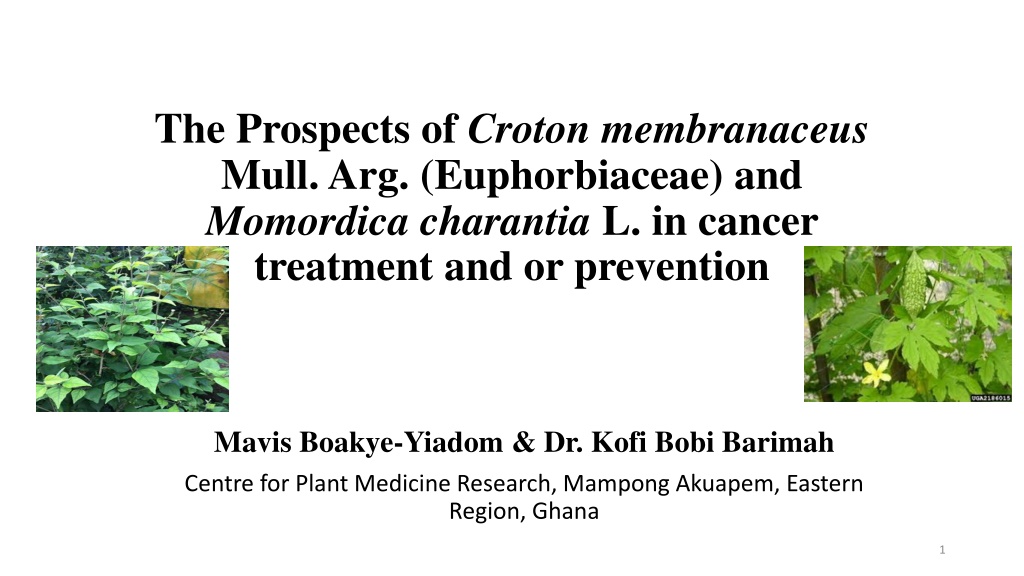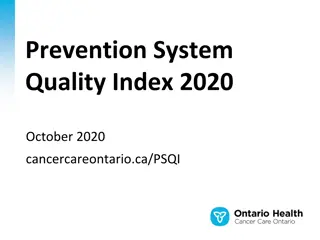Prospects of Croton Membranaceus and Momordica Charantia in Cancer Treatment and Prevention
Cancer treatment and prevention using Croton membranaceus and Momordica charantia are explored in this study by the Centre for Plant Medicine Research in Ghana. The research aims to determine the efficacy of these natural extracts on cancer cell growth through clinical studies and extraction methods. The expected outcomes include establishing their antioxidant activities and potential in cancer treatment, with recommendations for further comparative studies.
Download Presentation

Please find below an Image/Link to download the presentation.
The content on the website is provided AS IS for your information and personal use only. It may not be sold, licensed, or shared on other websites without obtaining consent from the author. Download presentation by click this link. If you encounter any issues during the download, it is possible that the publisher has removed the file from their server.
E N D
Presentation Transcript
The Prospects of Croton membranaceus Mull. Arg. (Euphorbiaceae) and Momordica charantia L. in cancer treatment and or prevention Mavis Boakye-Yiadom & Dr. Kofi Bobi Barimah Centre for Plant Medicine Research, Mampong Akuapem, Eastern Region, Ghana 1
Introduction Introduction Cancer is a disease associated with abnormal growth of cells in the body Approximately 70% of deaths from cancer occur in low- and middle-income countries such as Ghana. Also, the Daily Graphic in March, 2018 reported over 65,000 new cancer incident cases yearly in Ghana. Study background A capsule formulated from C. membranaceus, being used for the management of Benign Prostatic Hyperplasia at CPMR has yielded positive results. Larixol, an isolate from this same plant has a similar chemical structure as Manool; a known anti-cancer agent. M. charantia is known to have cancer treatment activities. 2
Aim To ascertain the prospects of Croton membranaceus (C. membranaceus) and Momordica charantia (M. charantia) in the treatment and or prevention of Cancer. Methods Ethanolic extracts of C. membranaceus and M. charantia will be used on various cancer cell lines such as Prostate and Breast as well as xenograft models to ascertain its effect and possible mode of action. Clinical study will be done using products developed as tinctures or capsules from the two plants. Recruitment of patients will be done in collaboration with Sweden Ghana Medical Centre. Patients monitoring will be by teams from Centre for Plant Medicine Research (CPMR), Mampong- Akuapem and Sweden Ghana Medical Centre, Accra. 3
Expected outcome Prevention of cancer cells growth by C. membranaceus and M. charantia will be ascertained. The anti-oxidant activity and the effectiveness of each plant in the treatment of Cancer will be established Conclusion The cancer prevention and or treatment activities of C. membranaceus and M. charantia would be ascertained Recommendations A comparative study could be done to compare the activities of Larixol, Manool and the whole plant extract of C. membranaceus on cancer cells. Different parts of M. charantia could be compared for its cancer treatment and or prevention activities. 4
Contact Information MAVIS BOAKYE-YIADOM CENTRE FOR PLANT MEDICINE RESEARCH, P.O.BOX 73, MAMPONG-AKUAPEM EASTERN REGION, GHANA EMAIL: magaby2752001@gmail.com or mboakye-yiadom@cpmr.org Telephone:+233235080355(WhatsApp) or +233264410358 (call) 5























